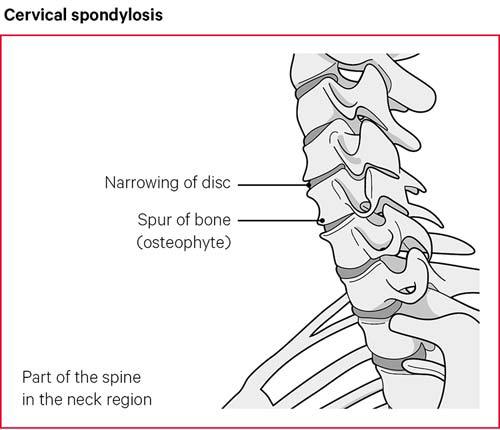How is the neck structured?
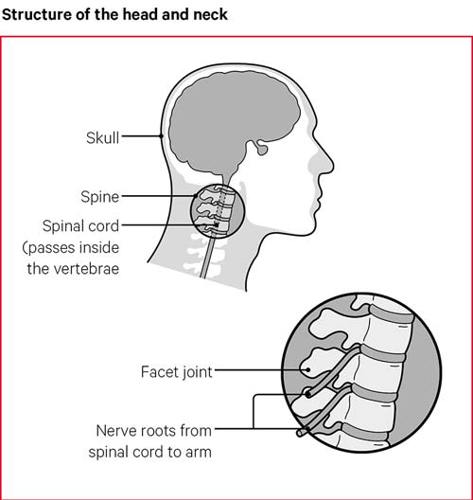
Your neck and back are made up of small bones called vertebrae. These are stacked on top of each other to form the spinal column.
The spinal column supports your head and protects the spinal cord. This is the main structure which links the network of nerves throughout your body. Messages travel along this network sending sensations, such as pain, to your brain.
The top seven bones in the spinal column form your neck, and these are called the cervical vertebrae. The bones are linked together by facet joints. These are small joints between your vertebrae that, together with your neck muscles, allow you to move your head in any direction.
Between the vertebrae are discs of cartilage. The discs act as shock absorbers and give the spine its flexibility. A slipped disc occurs when one of these discs slips slightly out of its natural position in the spine.
When to see a doctor
If your neck pain lasts more than a few days, you should see a healthcare professional. You should also speak to them if you:
- have symptoms other than pain and stiffness
- have pain, tingling, numbness or weakness in your arms or legs
- have sudden severe pain after a fall or injury
- suddenly develop neck stiffness along with difficulty lifting both arms above your head.
Some rare causes of neck pain include:
- a fracture
- an infection
- a tumour
- inflammation – which can happen in ankylosing spondylitis or meningitis.
If you suspect you have any of the above, see your doctor urgently.
Symptoms
The most common symptoms are:
Pain and stiffness
- You may feel pain in the middle or on either side of your neck, but it may also extend to the shoulder or to the upper chest.
- You may have pain or weakness in your arms.
- You may have tension headaches, where the pain can travel to the back of your head and sometimes into your ear or behind your eye.
- It may be painful to move your neck and your muscles may feel tight, especially if you’ve been sitting or sleeping in one position for a long time.
- You may notice that your neck won’t turn as far as it normally does, for example when you try to look over your shoulder while reversing the car.
If you have pain and stiffness in the neck that came on quickly, possibly overnight, and you have difficulty lifting both arms over your head, this could be a sign of a condition called polymyalgia rheumatica (PMR). This is an inflammatory condition of the muscles. It’s more common in people over the age of 65. If you think you have this condition, you should see a doctor as soon as possible.
Numbness or tingling
A nerve can become pinched when the muscles, bones or tissues surrounding it apply too much pressure. As a result, you may feel numbness, pins and needles or a tingling sensation that can be felt down your arm, sometimes right down to your fingers.
You’ll find that numbness and tingling will go away once the problem resolves itself. However, if your symptoms are severe, talk to your doctor; they may be able to prescribe drugs that target the pinched nerve, such as gabapentin or pregabalin.
Clicking and grating noises
You may hear or feel clicking or grating as you move your head. This is called crepitus, and it can be caused by air bubbles popping, or tissues and bones moving over each other, in the joint. Other joints often do this too, but noises from your neck usually seem louder because they’re happening closer to your ears. You may also find they’re more noticeable at night. While this is a common symptom and can sound alarming, it’s not serious.
Dizziness and blackouts
If you feel dizzy when looking up or turning your head, this may be due to pinching of the arteries that run alongside the spine, otherwise known as vertebral arteries. This can sometimes happen as a result of changes in the vertebrae. Pinching of these vertebral arteries can occasionally cause blackouts as the blood flow is temporarily reduced. However, blackouts can have other causes so it’s important to seek medical advice if this is happening to you.
Muscle spasms
Muscle spasms are the sudden stiffening of a muscle or groups of muscles in your body. Often there is no known cause and they can be very unpleasant. When it occurs in the neck it usually causes pain and stiffness down one side, which can make it difficult to turn your head.
It usually only lasts a few hours or days, although rarely it may continue for several weeks. You can try to ease the pain at home with gentle stretches, over-the-counter painkillers as well as heat or ice packs. People with muscle spasms report that applying heat is particularly soothing.
Other symptoms
If you have long-lasting neck pain and stiffness, particularly if your sleep is disturbed, then you may feel very tired and, not surprisingly, you may start to feel rather down or low in mood. Talking about your pain with friends, family or your doctor may help.
Causes
Neck pain is very common and most of us will have it at some point in our lives. Usually, neck pain is the result of holding your neck in the same position for too long. However, other things can also cause or contribute to neck pain, such as:
- worry or stress
- sleeping awkwardly
- an accident, which can cause whiplash
- a sprain or a strain
- a flare-up of cervical spondylosis; which can happen as the discs and joints in the spine age.
Many people develop a stiff and painful neck for no obvious reason. It may happen after sitting in a draught or after a minor twisting injury, for example while gardening. This is called non-specific neck pain. This is the most common type of neck pain and usually disappears after a few days, providing you keep gently moving your neck and rest when you need to.
You can often manage short spells of neck pain yourself using over-the-counter painkillers and gentle stretches. However, if your neck problem persists or significantly affects your everyday activities then it’s sensible to see a doctor or other healthcare professional.
Diagnosis
Most neck problems can be diagnosed and treated based on your symptoms and a simple examination, and it’s unlikely that you’ll need any special tests. Occasionally, your doctor may ask you to have an x-ray, a blood test or an MRI scan to rule out other important causes of neck pain.
Treatment
Simple self-help treatments and a day or two’s rest are often enough to clear up a spell of neck pain. But if you have a more complex or a continuing neck problem, a healthcare professional will be able to recommend other treatments and therapies that should help. If your pain isn’t settling, your doctor may also be able to prescribe stronger painkillers, although these aren’t suitable for everyone.
Physical treatments
Physiotherapists, chiropractors and osteopaths are all trained to treat neck problems. Treatment carried out by one of these therapists, along with home exercises, are often all that’s needed. They can suggest general or specific stretching and strengthening exercises for the neck.
It’s important to make sure that any physical treatments are given by qualified practitioners who are registered with the relevant body.
Manipulation
Manipulation is a type of manual therapy used to adjust parts of your body to treat stiffness. It can be uncomfortable at the time, so it’s important to understand what’s involved. Make sure you discuss your condition with your therapist and explain what symptoms you have been experiencing. This will enable them to make a more informed decision on what types of treatments you are most likely to benefit from.
It’s also a good idea to seek advice from a healthcare professional before you try manipulation as, even though some people report to have benefitted from it, it’s not suitable for everybody. If you have a condition such as osteoporosis, some therapies won’t be recommended.
The Alexander Technique
The Alexander technique is a method of teaching bodily awareness and reducing unwanted muscle tension. A qualified teacher will advise you on your standing and sitting posture and your patterns of movement. Some physiotherapists are trained in this technique, but it’s not always available on the NHS.
If you have spinal problems, such as a slipped disc, this technique might not be suitable for you.
TENS (transcutaneous electrical nerve stimulation)
A TENS machine is a small battery-driven machine which may help to reduce pain. Small pads are placed over the painful area and low-voltage electrical stimulation produces a pleasant tingling sensation. It’s suggested that this can interfere with pain signals from the nerves to the brain. You can buy TENS machines from pharmacies, but your physiotherapist may be able to let you borrow one to try first.
Collars
Some people find a special collar helpful to support the neck in cases of more serious or complex health problems. They are not routinely required.
Acupuncture
During a session of acupuncture, very fine needles are inserted, virtually painlessly, at a number of sites on the skin. These are not necessarily at the painful area. Acupuncture seems to relieve pain in the short term by interfering with the signals to your brain and by causing the release of natural painkillers, known as endorphins.
Injections
In a very small minority of cases, especially if you have continuing pain in the back of your head or arm, a long-acting local anaesthetic or a steroid injection may help. The injection is usually given into the small facet joints of your neck. These injections tend to be given in an x-ray department so that the specialist can position the needle precisely.
Surgery
Surgery is only rarely needed. It may be helpful if a nerve or the spinal cord is being squeezed and is causing weakness in the arm or severe pain that won’t go away. The surgeon will ask for a scan to look at the nerves and bones before discussing the pros and cons of surgery with you and whether to go ahead with an operation.
Drug treatments
Amitriptyline
If over-the-counter painkillers alone aren’t effective, you may be prescribed an additional medication called amitriptyline. This is also prescribed as an anti-depressant drug, but in lower doses it can be used to relax muscles and improve sleep.
You shouldn’t take amitriptyline if you have glaucoma, prostate problems or urinary retention.
Gabapentin and pregabalin
Gabapentin and pregabalin aren’t usually given as an initial treatment for ‘ordinary’ neck pain. However, if a pinched nerve in your neck is causing discomfort in your arm or arms, then these drugs can help by reducing nerve irritation. Depending on what drug you’re taking, you may need to trial it for a period of three to eight weeks to begin with. As with all drugs there can be side-effects, so they won’t be suitable for everyone. You should discuss this with your doctor.
Radiofrequency denervation
Radiofrequency denervation may help with long-term neck pain that originates from your facet joints. The procedure uses electrical currents produced by radio waves to heat up the tip of a needle. This is then used to stop nerve endings sending pain signals to your brain.
Radiofrequency denervation is only considered after other treatments have failed and steroid injections have successfully reduced your neck pain for a short period of time. It‘s aimed at being a longer-term solution to persistent pain as regular steroid injections are no longer advised.
Managing symptoms
Simple self-help treatments and a day or two's rest are often enough to clear up a spell of neck pain. If you do have a more complex or persistent neck problem, your doctor will be able to recommend other treatments and therapies.
Painkillers
Painkillers such as paracetamol will often help. It’s best to take them before the pain becomes very bad, but you shouldn’t take them more often than prescribed.
Over-the-counter non-steroidal anti-inflammatory drugs, such as ibuprofen, can also help. You can use these for a short course of treatment (about 5 – 10 days), but if they’ve not helped within this time then they’re unlikely to. If the pain returns when you stop taking the tablets, try another short course. You can rub anti-inflammatory gels or creams onto tender areas if you prefer.
NSAIDs can interact with other drugs such as warfarin, so it’s best to check with a pharmacist before you start taking them.
You shouldn’t take ibuprofen or aspirin if you’re pregnant, if you have asthma, a stomach ulcer or any heart problems, until you’ve spoken with your doctor or pharmacist.
Relaxation
Stress can make neck pain worse. One way of reducing the effects of stress is to learn how to relax your neck muscles. Aim for a balance between relaxation and exercise.
There are many relaxation, meditation or mindfulness tapes, CDs and MP3 downloads available. Your doctor or physiotherapist may be able to offer you some. If not, they’re also available to buy online and from high-street shops.
Using heat and ice packs
Applying a heat pack to your neck can help to ease pain. You can use a microwavable wheat bag, a hot-water bottle or a reusable heat pad; which you can buy from chemists and sports shops. An ice pack, or even a bag of frozen peas, can also be helpful.
Make sure you wrap heat or ice packs in a towel and don’t put them directly onto your neck to avoid burning or irritating your skin. You might want to consider applying a heat pack to your neck before and after exercise to help soothe the muscles.
Massage
Gentle massage of your neck muscles, particularly with aromatic oils, often helps. However, you should discuss the use of these oils with a healthcare professional as they won’t be suitable for everybody. You should be particularly careful if you’re pregnant or have a condition such as epilepsy.
Rubbing the area with ointments and creams can also help by reducing pain and producing a feeling of warmth. Some over-the-counter ointments contain capsaicin. This is an extract of the pepper plant that can be used as a painkiller. A similar but stronger preparation is available on prescription.
Posture
Pain and stiffness can be caused by:
- poor standing posture
- staying in the same position for too long
- a bed that’s too soft or too hard
- a pillow that's uncomfortably hard or soft
- poor posture at work.
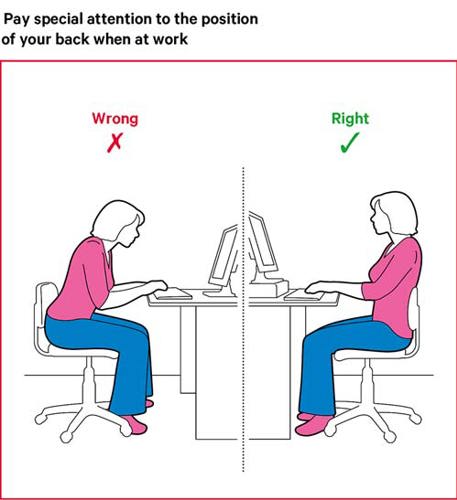
When you’re sitting, your feet should be flat on the floor and your knees should be slightly lower than your hips. Use a footrest if you think you’d be more comfortable.
A correctly adjusted chair will give you good support for your lower back. Hardback, upright chairs or straight-backed rocking chairs are better for your posture than low, soft, upholstered chairs or sofas. Using back supports can help your posture when sitting at home, at work or in the car. If you do a lot of reading, having the book or papers on a reading frame will often help to correct your posture.
If you use a desk at home or at work, you should check that the desk and computer screen aren’t too low and that your head isn’t bent forwards for long periods; as this can stretch your neck and may cause muscle pain. You should also check that your mouse and keyboard are comfortably positioned in relation to the screen. Regularly getting up to stretch and walk around will also help relieve tension and prevent aches and pains.
Some employers have occupational health specialists who can check that workstations are set up according to individual needs. Make sure you don’t spend a long time with your neck twisted sideways or cradling the telephone with your shoulder. If you find that this is happening to you, speak to your employer as they should be able to provide you with a headset.
Sleep
If your pillow is too firm or thick, it can make neck pain worse. Changing the number or position of pillows may be helpful. Your head and neck should be supported so your head is level with your body in a neutral position. The pillow should fill in the natural hollow between the neck and shoulders – a soft or moulded pillow may be useful, or a supportive roll inside your pillow case can support the hollow of your neck.
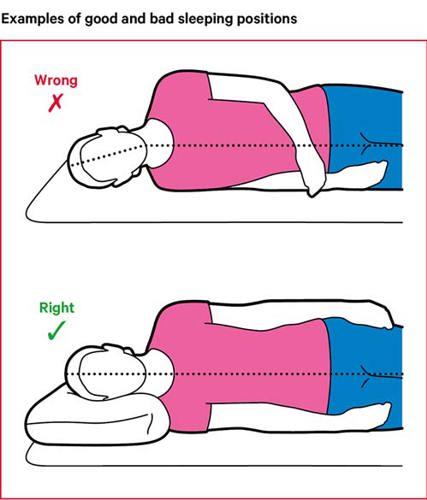
If your mattress doesn’t give your back proper support, it can also make neck pain worse. You may want to consider replacing it if it’s old or uncomfortable.
If you have trouble sleeping, you should try to wind down before bed. You can do this by having a hot bath, listening to the radio or reading a book. Some people also find keeping a sleep diary particularly useful. Try different things and see what works best for you.
If night-time pain is making it difficult for you to get to sleep, you can take a painkiller, such as paracetamol, before you go to bed. It’s unlikely to last through the night but should ease pain for long enough for you to go to sleep.
If all else fails, you might benefit from discussing your sleeping patterns with your doctor or a sleep expert.
Exercise
You may find a short period of rest is helpful initially to ease the pain and discomfort. But to prevent your neck muscles becoming weaker and your joints from stiffening, you should rest for as short a time as possible and certainly no more than a day or two. As soon as possible, start some gentle stretches and neck movements, as these can help the muscles and ligaments to relax and ease your pain and stiffness. You might want to consider seeing a physiotherapist as they can give you advice on some of the best exercises to do for your condition.
You should do some simple stretching and strengthening exercises every day. These can help to increase the strength of your muscles, ease stiffness, and restore your range of movement. Start by exercising very gently and gradually build up how much you do. You can find examples of exercises for the neck on our webpage.
As with any physical activity, some aches or discomfort during or following exercise are normal and should be expected. But if an exercise makes your symptoms significantly worse you should stop doing it.
It’s also important to find some form of exercise that you enjoy and to keep doing it. Walking, swimming, and exercise classes such as yoga or Pilates are all popular and will help with your general health and fitness.
Related information
-
Let's Move with Leon
Sign up to Let’s Move with Leon our weekly email programme of 30-minute movement sessions, presented by fitness expert Leon Wormley.
-
Let's Move
Sign up to Let’s Move to receive a wide range of content about moving with arthritis – from exercise videos to stories and interviews with experts – straight to your email inbox.
Persistent neck pain
In some cases, persistent neck pain has a specific cause, such as a damaged facet joint or disc. However, neck pain quite often continues even after the original problem has settled down. Lack of movement can cause your neck muscles to become weak and stiff. They will then tire more easily and will be more likely to hurt when you move them.
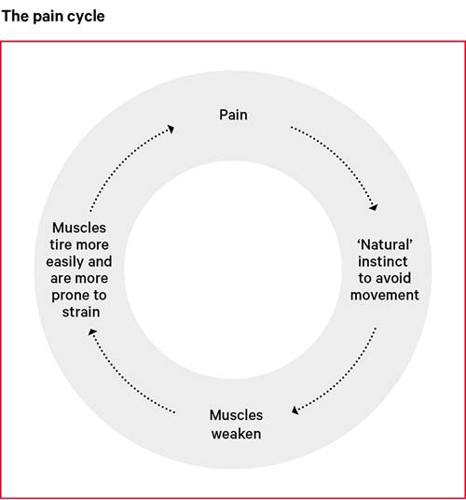
Over time you may start avoiding more and more activities and this can start to affect your work, social life, personal relationships, hobbies and interests.
As you do less of the things you enjoy and start to lose confidence you may start to feel anxious or depressed. You may feel that family members and medical professionals appear unhelpful or unsympathetic. If you’re anxious or depressed, you may not feel like exercising or doing everyday activities, so your muscles become weaker still, and so it goes on.
This can happen to anyone, and the longer it continues the harder it’ll be for you to recover your movement, activities and confidence.
Working with neck pain
Overall, getting back to work sooner rather than later is helpful for most people. In the past, people were advised to rest up in bed, but we now realise that it does more harm than good. It’s much better to keep moving, even if you need to take some painkillers to allow you to do so.
Most people are able to return to work within 2−3 days, although this varies from person to person and depends on the type of job you do.
You don’t need to wait until your neck problem has gone. In many cases, the longer you’re off work the more likely you are to develop longer-term problems and the less likely you are to return to work.
It’s important to keep in contact with your employer and discuss what can be done to help you return to work. If your work involves physically demanding tasks, you might find it useful to work shorter hours or move to more desk-based duties for a couple of weeks.
If you have an occupational health adviser at your workplace, they can help advise what work you are fit to do and arrange any simple adjustments to help you to cope. If you are having difficulties travelling to or from work or need an item of equipment, the Government’s Access to Work Scheme might be able to help.
If you are unable to get back to work after two weeks of absence because of your neck pain, you should talk to your doctor and employer about getting physiotherapy or other treatments that can get you moving again.
You can get further advice through your local Jobcentre Plus and the Government’s Fit for Work website.
Research and new developments
Research has helped us to understand the make-up and function of the discs between our vertebrae and has demonstrated that inherited factors affect the normal wear of the spine. Research has also shown that acupuncture can be an effective treatment for back and neck pain.
Discoveries about the effect of stress, anxiety and depression as well as the importance of exercises, are changing the way doctors think about neck pain. This will be improved further as a result of ongoing research to monitor the differences in musculoskeletal care across the UK.
Further help
If your neck pain continues despite treatment and is affecting your day-to-day activities or perhaps is affecting your mood, a pain management programme may help you. These programmes focus on improved coping techniques and better long-term self-management strategies.
While they won’t cure the pain, they should help you to have a better quality of life in spite of the pain. Pain management programmes are generally outpatient group sessions run by a team of healthcare professionals including doctors, physiotherapists, psychologists and sometimes nurses, occupational therapists and other specialist clinicians.
Make sure you talk to your doctor as they may be able to refer you for a pain management programme if they think you would benefit from it.
Yoga, Pilates and other similar classes are a great way to keep fit while simultaneously improving your wellbeing.
If you have any questions or want to talk to someone about neck pain, you can try giving our helpline a ring on 0800 5200 520 for free.
